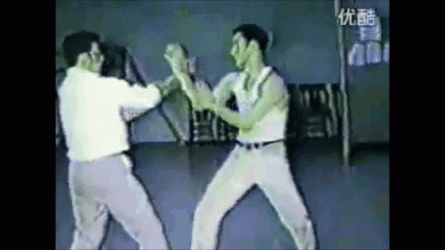If White takes a long path to get his arm under then he's not going to get under him as he's showing. What's going to happen is that Reds' arm that he pulls is going to be in the center resulting in an over under grab, where reds arm gets trapped between white's body, while whites arm goes under red's free arm.
It's true, that is the more likely outcome of this technique-- that the defender (red) will pull his arm back into position. However, just as with Gung Fu (or any other style) of techniques, you have to examine this from a step-by-step moment-to-moment angle, and apply real-world physics, in order to discuss the theory.
So when the attacker performs the arm-drag, one of two things will happen (assuming the defender actively defends, and doesn't just get dragged to the ground/wherever the attacker wants)
1. Defender is pulled off-balance with arm extended for just a moment (after which he will almost certainly attempt to re-centre the arm close to his body, or else attempt to wrap the attacker as a counter-attack).
2. Defender is stronger than attacker and/or has better positional balance, and the attacker's opening to the technique will simply fail.
In the case of #1, this technique will work. The technique is counting on this to be the case.
In the case of #2, the attacker will either attempt to drag again or be forced to move on to something else.
This technique and the issues with it however, display the primary weakness of wrestling in general: it relies on raw strength too much for all of its techniques.
(ASIDE: That said, yes, I understand that having better wrestling can allow you to win against opponents who are stronger/bigger than you-- but bigger/stronger opponents is a greater disadvantage in wrestling than it is in
any other combat art I've ever encountered. Wrestling works great, but it is
really un-fun to wrestle with guys who outweigh/outlift you, and I don't find that same issue in any of the other 10+ arts I've trained in. )
I guess the original point of this post is that the technique can work; but the weaknesses JowGa pointed out are true.
CLARIFICATION: It will work due to momentum and balance. The defender will have to spend a "beat" recovering balance and retrieving his arm position. In that same moment, the attacker can simultaneously drop his level, and reposition his arm below the defender's. Even if the defender recovers his arm to centre-mass at that point, the attacker's arm will be below it. The question becomes whether the attacker is strong/skilled enough to move the defender
fully in the first place-- and if not, is he
fast enough to get his arm below the defender's anyway.
It leaves a lot to circumstance, which a lot of martial artists (myself included) would argue means that it's not a very good/reliable technique.
You can consider my judgment in this biased, however, because I am not a fan of wrestling (despite that I still actively train in it today).


